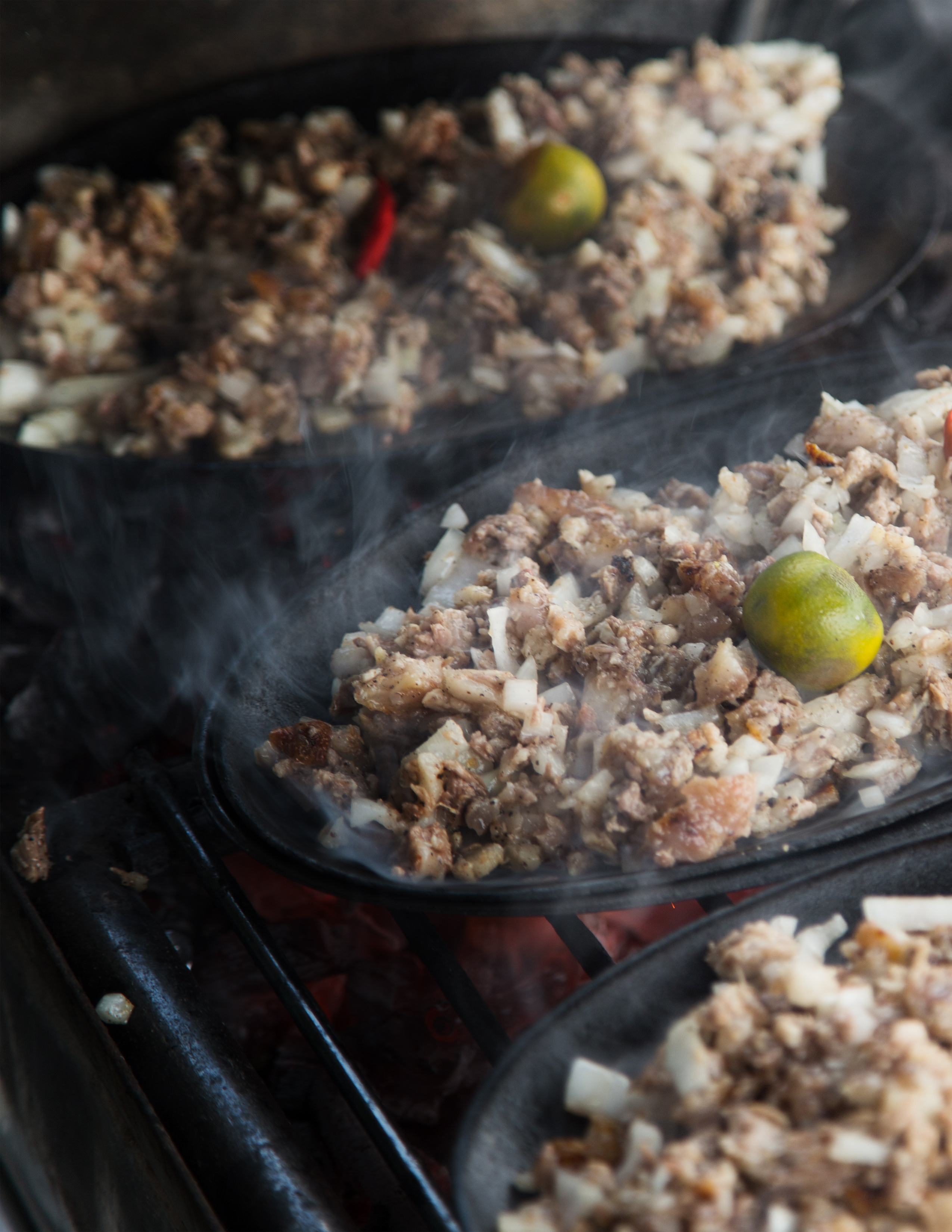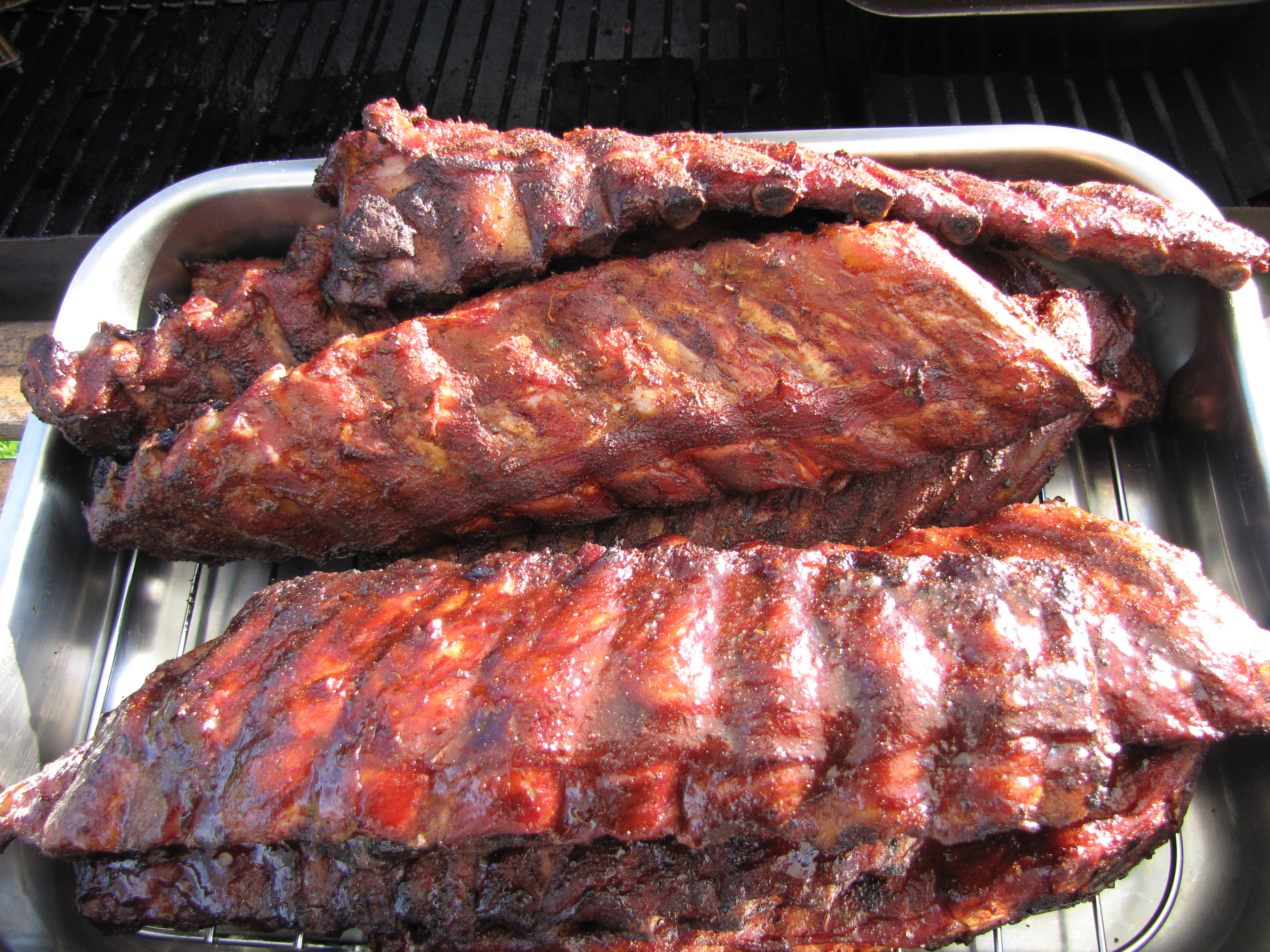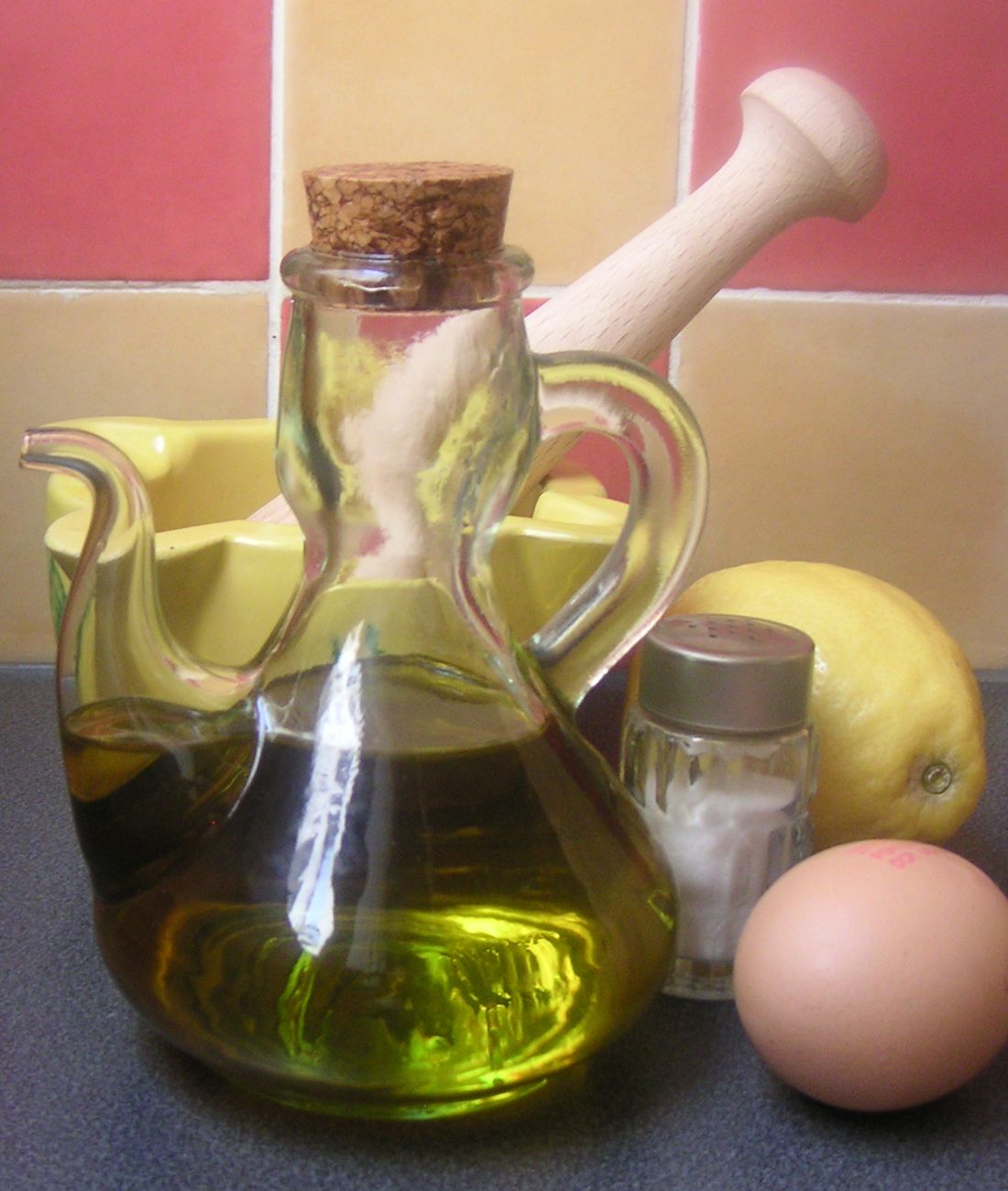|
Dinakdakan
Dinakdakan, also known as warek-warek, is a Filipino dish consisting of various pork head parts, red onions, siling haba or siling labuyo chilis, ginger, black peppercorns, calamansi juice, and bay leaves. The pork parts are first boiled in the aromatics for an hour or so until tender, and then further grilled until lightly charred. They are chopped into small pieces and served in a creamy sauce traditionally made from mashed cooked pig's brain, though this is commonly substituted with mayonnaise. The pork parts used commonly include pork jowls (''maskara''), pork collar, and ears. Sometimes pork tongue, liver, stomach, and intestines are also included. Dinakdakan is most commonly served as ''pulutan'', appetizers that are eaten with beer or other alcoholic drinks. But it can also be eaten with rice. Dinakdakan is very similar to the sisig of Kapampangan cuisine, except that it is not as finely chopped and is always served with in a sauce made from mashed brain or mayonnaise. ... [...More Info...] [...Related Items...] OR: [Wikipedia] [Google] [Baidu] |
Sisig
''Sisig'' ( ) is a Filipino dish made from parts of a pig's face and belly, and chicken liver which is usually seasoned with ''calamansi'', onions, and chili peppers. It originates from the Pampanga region in Luzon. ''Sisig'' is a staple of Kapampangan cuisine. The city government of Angeles, Pampanga, through City Ordinance No. 405, series of 2017, declared sizzling ''sisig babi'' ("pork ''sisig''") as a tangible heritage of Angeles City.Angeles Ordinance No. 405, Series of 2017 “An ordinance declaring Sizzling Sisig Babi as an intangible cultural heritage of Angeles, and establishing systems and policies in safeguarding the original recipe of Sizzling Sisig, providing mechanisms of implementation, and for other related purposes”) Origin The earliest known record of the word ''sisig'' can be traced back to 1732, and was recorded by Augustinian friar Diego Bergaño in his ''Vocabulary of the Kapampangan Language in Spanish and Dictionary of the Spanish Language in Kapamp ... [...More Info...] [...Related Items...] OR: [Wikipedia] [Google] [Baidu] |
Sisig
''Sisig'' ( ) is a Filipino dish made from parts of a pig's face and belly, and chicken liver which is usually seasoned with ''calamansi'', onions, and chili peppers. It originates from the Pampanga region in Luzon. ''Sisig'' is a staple of Kapampangan cuisine. The city government of Angeles, Pampanga, through City Ordinance No. 405, series of 2017, declared sizzling ''sisig babi'' ("pork ''sisig''") as a tangible heritage of Angeles City.Angeles Ordinance No. 405, Series of 2017 “An ordinance declaring Sizzling Sisig Babi as an intangible cultural heritage of Angeles, and establishing systems and policies in safeguarding the original recipe of Sizzling Sisig, providing mechanisms of implementation, and for other related purposes”) Origin The earliest known record of the word ''sisig'' can be traced back to 1732, and was recorded by Augustinian friar Diego Bergaño in his ''Vocabulary of the Kapampangan Language in Spanish and Dictionary of the Spanish Language in Kapamp ... [...More Info...] [...Related Items...] OR: [Wikipedia] [Google] [Baidu] |
List Of Pork Dishes
This is a list of notable pork dishes. Pork is the culinary name for meat from the domestic pig (''Sus domesticus''). It is one of the most commonly consumed meats worldwide,Raloff, JanetFood for Thought: Global Food Trends Science News Online. May 31, 2003. with evidence of pig husbandry dating back to 5000 BC. Pork is eaten both freshly cooked and preserved. The consumption of pork is prohibited in Judaism, Islam, and some Christian denominations such as Seventh-day Adventism. Fresh pork may contain trichinosis, a parasitic disease caused by eating raw or undercooked pork or wild game infected with the larvae of a species of roundworm ''Trichinella spiralis'', commonly called the trichina worm. In the United States, the U.S. Department of Agriculture recommends cooking ground pork, that is obtained from pig carcasses, to an internal temperature of 160 °F, followed by a 3-minute rest, and cooking whole cuts to a minimum internal temperature of 145 °F, also followed ... [...More Info...] [...Related Items...] OR: [Wikipedia] [Google] [Baidu] |
Paklay
''Paklay'' refers to two different Filipino braised dishes from the Mindanao and Visayas Islands characterized by julienned ingredients. They are eaten with rice or served as ''pulutan'' (side dishes) with alcohol. In Mindanao and Central and Eastern Visayas, it refers to a dish made from various beef, pork, or goat tripe with julienned ginger, bamboo shoots (''labong''), carrots, bell pepper, ''siling mahaba'' chilis and tomatoes, garlic, onions, and black pepper, among other ingredients. It is commonly slightly soured with fruits like pineapple, tamarind, or unripe starfruit. Among the Hiligaynon people of Western Visayas, on the other hand, it refers to sautéed bamboo shoots with fish or shrimp, tomatoes, ground pork or beef, onions, garlic, and other spices. See also *Dinakdakan *Dinuguan ''Dinuguan'' () is a Filipino savory stew usually of pork offal (typically lungs, kidneys, intestines, ears, heart and snout) and/or meat simmered in a rich, spicy dark gravy of pig ... [...More Info...] [...Related Items...] OR: [Wikipedia] [Google] [Baidu] |
Philippines
The Philippines (; fil, Pilipinas, links=no), officially the Republic of the Philippines ( fil, Republika ng Pilipinas, links=no), * bik, Republika kan Filipinas * ceb, Republika sa Pilipinas * cbk, República de Filipinas * hil, Republika sang Filipinas * ibg, Republika nat Filipinas * ilo, Republika ti Filipinas * ivv, Republika nu Filipinas * pam, Republika ning Filipinas * krj, Republika kang Pilipinas * mdh, Republika nu Pilipinas * mrw, Republika a Pilipinas * pag, Republika na Filipinas * xsb, Republika nin Pilipinas * sgd, Republika nan Pilipinas * tgl, Republika ng Pilipinas * tsg, Republika sin Pilipinas * war, Republika han Pilipinas * yka, Republika si Pilipinas In the recognized optional languages of the Philippines: * es, República de las Filipinas * ar, جمهورية الفلبين, Jumhūriyyat al-Filibbīn is an archipelagic country in Southeast Asia. It is situated in the western Pacific Ocean and consists of around 7,641 islands t ... [...More Info...] [...Related Items...] OR: [Wikipedia] [Google] [Baidu] |
Bay Leaves
The bay leaf is an aromatic leaf commonly used in cooking. It can be used whole, either dried or fresh, in which case it is removed from the dish before consumption, or less commonly used in ground form. It may come from several species of tree, the bay laurel and the California bay tree being the most common. The flavor that a bay leaf imparts to a dish has not been universally agreed upon, but most agree it is a subtle addition. Sources Bay leaves come from several plants, such as: *Bay laurel (''Laurus nobilis'', Lauraceae). Fresh or dried bay leaves are used in cooking for their distinctive flavour and fragrance. The leaves should be removed from the cooked food before eating (see safety section below). The leaves are often used to flavour soups, stews, braises and pâtés in many countries. The fresh leaves are very mild and do not develop their full flavour until several weeks after picking and drying. *California bay leaf. The leaf of the California bay tree (''Umbel ... [...More Info...] [...Related Items...] OR: [Wikipedia] [Google] [Baidu] |
Philippine Cuisine
Filipino cuisine ( fil, lutong Pilipino/pagkaing Pilipino) is composed of the cuisines of more than a hundred distinct ethnolinguistic groups found throughout the Philippine archipelago. A majority of mainstream Filipino dishes that compose Filipino cuisine are from the food traditions of various ethnolinguistic groups and tribes of the archipelago, including the Ilocano, Pangasinan, Kapampangan, Tagalog, Bicolano, Visayan, Chavacano and Maranao ethnolinguistic groups. The styles of preparation and dishes associated with them have evolved over many centuries from a largely indigenous (largely Austronesian) base shared with maritime Southeast Asia with varied influences from Chinese, Spanish and American cuisines, in line with the major waves of influence that had enriched the cultures of the archipelago, as well as others adapted to indigenous ingredients and the local palate. [...More Info...] [...Related Items...] OR: [Wikipedia] [Google] [Baidu] |
Kapampangan Cuisine
Kapampangan cuisine ( pam, Lútûng Kapampángan) differed noticeably from that of other groups in the Philippines. The Kapampangan kitchen is the biggest and widely used room in the traditional Kapampangan household. When the Philippines was under Spanish rule, Spanish friars and sailors taught Kapampangans the basics of Spanish cooking. The Kapampangans were able to produce a unique blend that surprised the Spanish palate. Soon Spanish friars and government officials were entertaining foreign guests at the expense of Kapampangan households. In the late 18th century, the Arnedo clan of Apalit were commissioned by the colonial government to entertain foreign dignitaries that included a Cambodian prince and a Russian archduke. Kapampangans were given the task of creating the meal and menu that was served in the proclamation of the First Philippine Republic in Malolos, Bulacan. Some popular Kapampangan dishes that have won over the Filipino palate across the country include its ... [...More Info...] [...Related Items...] OR: [Wikipedia] [Google] [Baidu] |
Appetizer
An hors d'oeuvre ( ; french: hors-d'œuvre ), appetiser or starter is a small dish served before a meal in European cuisine. Some hors d'oeuvres are served cold, others hot. Hors d'oeuvres may be served at the dinner table as a part of the meal, or they may be served before seating, such as at a reception or cocktail party. Formerly, hors d'oeuvres were also served between courses.''Oxford English Dictionary'', First Edition, 189''s.v.''/ref> There are two types of hors d'oeuvre from service point of view: # General hors d'oeuvre # Classical hors d'oeuvre General hors d'oeuvres include cold preparations such as salad, cold meat, and fish. Classical hors d'oeuvres include fruit juice and soft drinks, grapefruit, shellfish cocktail, and so on. Typically smaller than a main dish, an hors d'oeuvre is often designed to be eaten by hand. Etymology in French literally means "outside the work"; that is, "not part of the ordinary set of courses in a meal". In practice, i ... [...More Info...] [...Related Items...] OR: [Wikipedia] [Google] [Baidu] |
Pulutan
Filipino cuisine ( fil, lutong Pilipino/pagkaing Pilipino) is composed of the cuisines of more than a hundred distinct ethnolinguistic groups found throughout the Philippine archipelago. A majority of mainstream Filipino dishes that compose Filipino cuisine are from the food traditions of various ethnolinguistic groups and tribes of the archipelago, including the Ilocano, Pangasinan, Kapampangan, Tagalog, Bicolano, Visayan, Chavacano and Maranao ethnolinguistic groups. The styles of preparation and dishes associated with them have evolved over many centuries from a largely indigenous (largely Austronesian) base shared with maritime Southeast Asia with varied influences from Chinese, Spanish and American cuisines, in line with the major waves of influence that had enriched the cultures of the archipelago, as well as others adapted to indigenous ingredients and the local palate. [...More Info...] [...Related Items...] OR: [Wikipedia] [Google] [Baidu] |
Mayonnaise
Mayonnaise (; ), colloquially referred to as "mayo" , is a thick, cold, and creamy sauce or dressing commonly used on sandwiches, hamburgers, composed salads, and French fries. It also forms the base for various other sauces, such as tartar sauce, fry sauce, remoulade, salsa golf, and rouille. Mayonnaise is an emulsion of oil, egg yolk, and an acid, either vinegar or lemon juice; there are many variants using additional flavorings. The color varies from near-white to pale yellow, and its texture from a light cream to a thick gel. Commercial eggless imitations are made for those who avoid chicken eggs because of egg allergies, to limit dietary cholesterol, or because they are vegans. History ''Mayonnaise'' is a French cuisine appellation that seems to have appeared for the first time in 1806. The hypotheses invoked over time as to the origin(s) of mayonnaise have been numerous and contradictory. Most hypotheses do however agree on the geographical origin of the sauce ... [...More Info...] [...Related Items...] OR: [Wikipedia] [Google] [Baidu] |
Calamansi
Calamansi (''Citrus'' × ''microcarpa''), also known as calamondin, Philippine lime, or Philippine lemon, is an economically important citrus hybrid predominantly cultivated in the Philippines. It is native to the Philippines, Borneo, Sumatra, and Sulawesi in Indonesia in Southeast Asia, as well as southern China and Taiwan in East Asia. Calamansi is ubiquitous in traditional Filipino cuisine. It is naturally very sour, and is used in various condiments, beverages, dishes, marinades, and preserves. Calamansi is also used as an ingredient in Malaysian and Indonesian cuisines. Calamansi is a hybrid between kumquat (formerly considered as belonging to a separate genus ''Fortunella'') and another species of ''Citrus'' (in this case probably the mandarin orange). Names Calamansi is the Philippine English spelling of Tagalog ''kalamansi'' (), and is the name by which it is most widely known in the Philippines. In parts of the United States (notably Florida), calamansi is also ... [...More Info...] [...Related Items...] OR: [Wikipedia] [Google] [Baidu] |


.jpg)



_(2).jpg)


